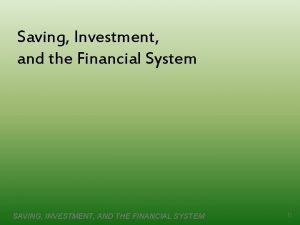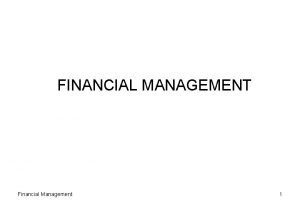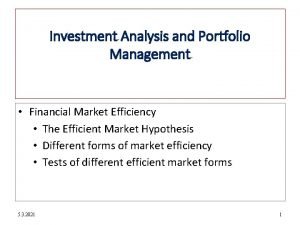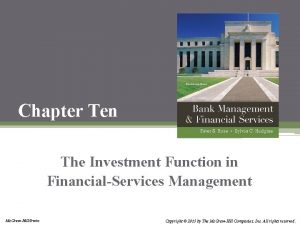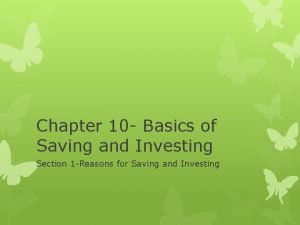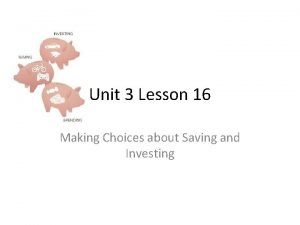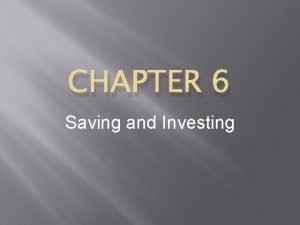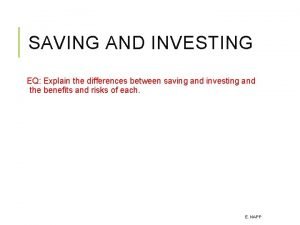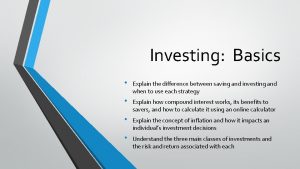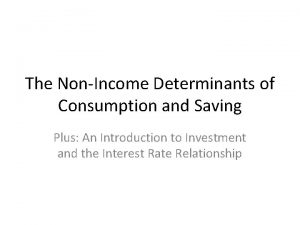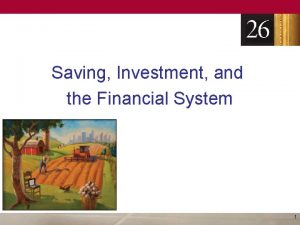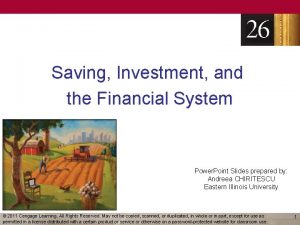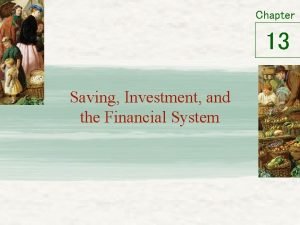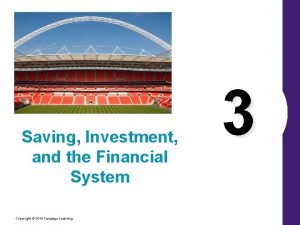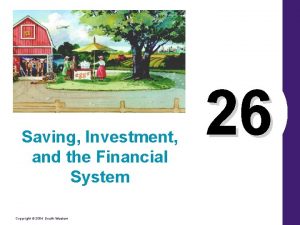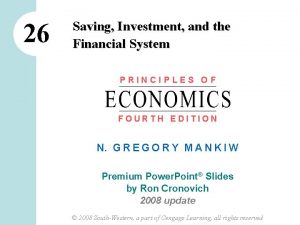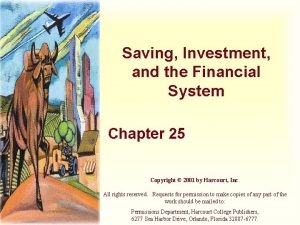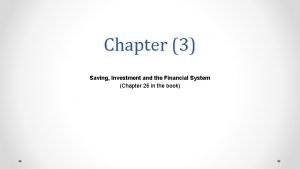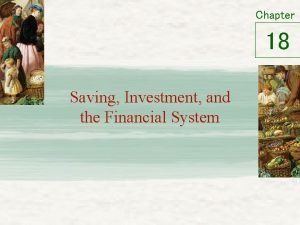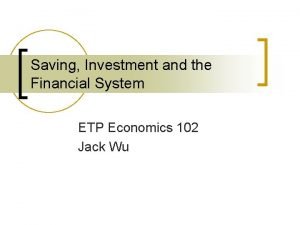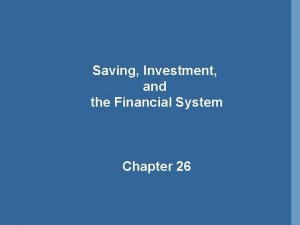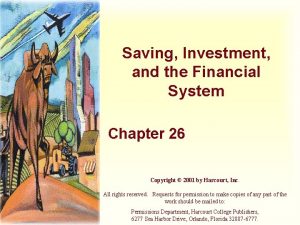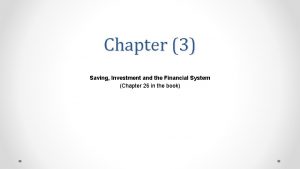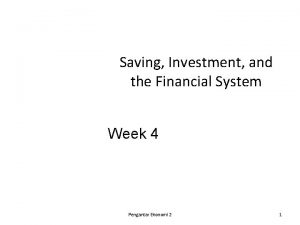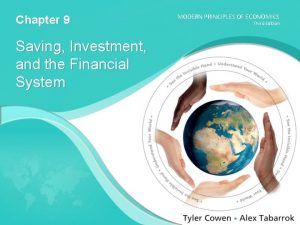26 Saving Investment and the Financial System Power







































- Slides: 39

26 Saving, Investment, and the Financial System Power. Point Slides prepared by: Andreea CHIRITESCU Eastern Illinois University © 2015 Cengage Learning. All Rights Reserved. May not be copied, scanned, or duplicated, in whole or in part, except for use as permitted in a license distributed with a certain product or service or otherwise on a password-protected website for classroom use. 1

Financial Institutions • Financial system – Group of institutions in the economy • That help match one person’s saving with another person’s investment – Moves the economy’s scarce resources from savers to borrowers • Financial institutions – Financial markets – Financial intermediaries © 2015 Cengage Learning. All Rights Reserved. May not be copied, scanned, or duplicated, in whole or in part, except for use as permitted in a license distributed with a certain product or service or otherwise on a password-protected website for classroom use. 2

Financial Markets • Financial markets – Savers can directly provide funds to borrowers – The bond market – The stock market © 2015 Cengage Learning. All Rights Reserved. May not be copied, scanned, or duplicated, in whole or in part, except for use as permitted in a license distributed with a certain product or service or otherwise on a password-protected website for classroom use. 3

Financial Markets • The bond market – Bond: certificate of indebtedness • Date of maturity, when the loan will be repaid • Rate of interest, paid periodically until the date of maturity • Principal, amount borrowed – Borrowing from the public • Used by large corporations, the federal government, or state and local governments © 2015 Cengage Learning. All Rights Reserved. May not be copied, scanned, or duplicated, in whole or in part, except for use as permitted in a license distributed with a certain product or service or otherwise on a password-protected website for classroom use. 4

Financial Markets • The bond market – Term: length of time until maturity • A few months, 30 years, perpetuity • Long-term bonds are riskier than short-term bonds – Long-term bonds usually pay higher interest rates © 2015 Cengage Learning. All Rights Reserved. May not be copied, scanned, or duplicated, in whole or in part, except for use as permitted in a license distributed with a certain product or service or otherwise on a password-protected website for classroom use. 5

Financial Markets • The bond market – Credit risk: probability of default • Probability that the borrower will fail to pay some of the interest or principal • Higher interest rates for higher probability of default • U. S. government bonds tend to pay low interest rates • Junk bonds, very high interest rates – Issued by financially shaky corporations © 2015 Cengage Learning. All Rights Reserved. May not be copied, scanned, or duplicated, in whole or in part, except for use as permitted in a license distributed with a certain product or service or otherwise on a password-protected website for classroom use. 6

Financial Markets • The bond market – Tax treatment • Interest on most bonds is taxable income • Municipal bonds – Issued by state and local governments – Owners are not required to pay federal income tax on the interest income – Lower interest rate © 2015 Cengage Learning. All Rights Reserved. May not be copied, scanned, or duplicated, in whole or in part, except for use as permitted in a license distributed with a certain product or service or otherwise on a password-protected website for classroom use. 7

Financial Markets • The stock market – Stock: claim to partial ownership in a firm • A claim to the profits that a firm makes – Organized stock exchanges • Stock prices: demand supply – Equity finance • Sale of stock to raise money – Stock index • Average of a group of stock prices © 2015 Cengage Learning. All Rights Reserved. May not be copied, scanned, or duplicated, in whole or in part, except for use as permitted in a license distributed with a certain product or service or otherwise on a password-protected website for classroom use. 8

Financial Intermediaries • Financial intermediaries – Savers can indirectly provide funds to borrowers – Banks – Mutual funds © 2015 Cengage Learning. All Rights Reserved. May not be copied, scanned, or duplicated, in whole or in part, except for use as permitted in a license distributed with a certain product or service or otherwise on a password-protected website for classroom use. 9

Financial Intermediaries • Banks – Take in deposits from savers • Banks pay interest – Make loans to borrowers • Banks charge interest – Facilitate purchasing of goods and services • Checks: medium of exchange © 2015 Cengage Learning. All Rights Reserved. May not be copied, scanned, or duplicated, in whole or in part, except for use as permitted in a license distributed with a certain product or service or otherwise on a password-protected website for classroom use. 10

Financial Intermediaries • Mutual funds – Institution that sells shares to the public – Uses the proceeds to buy a portfolio of stocks and bonds – Advantages – Diversification; professional money managers © 2015 Cengage Learning. All Rights Reserved. May not be copied, scanned, or duplicated, in whole or in part, except for use as permitted in a license distributed with a certain product or service or otherwise on a password-protected website for classroom use. 11

National Income Accounts • Rules of national income accounting – Important identities • Identity – An equation that must be true because of the way the variables in the equation are defined – Clarify how different variables are related to one another © 2015 Cengage Learning. All Rights Reserved. May not be copied, scanned, or duplicated, in whole or in part, except for use as permitted in a license distributed with a certain product or service or otherwise on a password-protected website for classroom use. 12

Accounting Identities • Gross domestic product (GDP) – Total income – Total expenditure • Y = C + I + G + NX • Y = gross domestic product, GDP • C = consumption • I = investment • G = government purchases • NX = net exports © 2015 Cengage Learning. All Rights Reserved. May not be copied, scanned, or duplicated, in whole or in part, except for use as permitted in a license distributed with a certain product or service or otherwise on a password-protected website for classroom use. 13

Accounting Identities • Closed economy – Doesn’t interact with other economies – NX Component does not exist • Open economy – Interact with other economies – NX ≠ 0 © 2015 Cengage Learning. All Rights Reserved. May not be copied, scanned, or duplicated, in whole or in part, except for use as permitted in a license distributed with a certain product or service or otherwise on a password-protected website for classroom use. 14

Accounting Identities • Assume closed economy: NX = 0 • Y=C+I+G • National saving (saving), S • Total income in the economy that remains after paying for consumption and government purchases • Y–C–G=I • S=Y–C–G • S=I © 2015 Cengage Learning. All Rights Reserved. May not be copied, scanned, or duplicated, in whole or in part, except for use as permitted in a license distributed with a certain product or service or otherwise on a password-protected website for classroom use. 15

Accounting Identities • T = taxes minus transfer payments • S=Y–C–G • S = (Y – T – C) + (T – G) • Private saving, Y – T – C – Income that households have left after paying for taxes and consumption • Public saving, T – G – Tax revenue that the government has left after paying for its spending © 2015 Cengage Learning. All Rights Reserved. May not be copied, scanned, or duplicated, in whole or in part, except for use as permitted in a license distributed with a certain product or service or otherwise on a password-protected website for classroom use. 16

Accounting Identities • Budget surplus: T – G > 0 – Excess of tax revenue over government spending • Budget deficit: T – G < 0 – Shortfall of tax revenue from government spending © 2015 Cengage Learning. All Rights Reserved. May not be copied, scanned, or duplicated, in whole or in part, except for use as permitted in a license distributed with a certain product or service or otherwise on a password-protected website for classroom use. 17

Saving and Investing • Accounting identity: S = I • Saving = Investment – For the economy as a whole – One person’s savings can finance another person’s investment © 2015 Cengage Learning. All Rights Reserved. May not be copied, scanned, or duplicated, in whole or in part, except for use as permitted in a license distributed with a certain product or service or otherwise on a password-protected website for classroom use. 18

The Market for Loanable Funds • Market for loanable funds – Market • Those who want to save supply funds • Those who want to borrow to invest demand funds – One interest rate • Return to saving • Cost of borrowing – Assumption • Single financial market © 2015 Cengage Learning. All Rights Reserved. May not be copied, scanned, or duplicated, in whole or in part, except for use as permitted in a license distributed with a certain product or service or otherwise on a password-protected website for classroom use. 19

The Market for Loanable Funds • Supply and demand of loanable funds – Source of the supply of loanable funds • Saving – Source of the demand for loanable funds • Investment – Price of a loan = real interest rate • Borrowers pay for a loan • Lenders receive on their saving © 2015 Cengage Learning. All Rights Reserved. May not be copied, scanned, or duplicated, in whole or in part, except for use as permitted in a license distributed with a certain product or service or otherwise on a password-protected website for classroom use. 20

The Market for Loanable Funds • Supply and demand of loanable funds – As interest rate rises • Quantity demanded declines • Quantity supplied increases – Demand curve • Slopes downward – Supply curve • Slopes upward © 2015 Cengage Learning. All Rights Reserved. May not be copied, scanned, or duplicated, in whole or in part, except for use as permitted in a license distributed with a certain product or service or otherwise on a password-protected website for classroom use. 21

Figure 1 The Market for Loanable Funds Interest Rate Supply 5% Demand 0 $1, 200 Loanable Funds (in billions of dollars) The interest rate in the economy adjusts to balance the supply and demand for loanable funds. The supply of loanable funds comes from national saving, including both private saving and public saving. The demand for loanable funds comes from firms and households that want to borrow for purposes of investment. Here the equilibrium interest rate is 5 percent, and $1, 200 billion of loanable funds are supplied and demanded. © 2015 Cengage Learning. All Rights Reserved. May not be copied, scanned, or duplicated, in whole or in part, except for use as permitted in a license distributed with a certain product or service or otherwise on a password-protected website for classroom use. 22

The Market for Loanable Funds • Government policies – Can affect the economy’s saving and investment • Saving incentives • Investment incentives • Government budget deficits and surpluses © 2015 Cengage Learning. All Rights Reserved. May not be copied, scanned, or duplicated, in whole or in part, except for use as permitted in a license distributed with a certain product or service or otherwise on a password-protected website for classroom use. 23

Policy 1: Saving Incentives • Shelter some saving from taxation – Affect supply of loanable funds – Increase in supply • Supply curve shifts right – New equilibrium • Lower interest rate • Higher quantity of loanable funds – Greater investment © 2015 Cengage Learning. All Rights Reserved. May not be copied, scanned, or duplicated, in whole or in part, except for use as permitted in a license distributed with a certain product or service or otherwise on a password-protected website for classroom use. 24

Figure 2 Saving Incentives Increase the Supply of Loanable Funds Interest Rate Supply, S 1 S 2 1. Tax incentives for saving increase the supply of loanable funds. . . 5% 4% 2. . which reduces the equilibrium interest rate 0. . . Demand $1, 200 $1, 600 Loanable Funds (in billions of dollars) 3. . and raises the equilibrium quantity of loanable funds. A change in the tax laws to encourage Americans to save more would shift the supply of loanable funds to the right from S 1 to S 2. As a result, the equilibrium interest rate would fall, and the lower interest rate would stimulate investment. Here the equilibrium interest rate falls from 5 percent to 4 percent, and the equilibrium quantity of loanable funds saved and invested rises from $1, 200 billion to $1, 600 billion. © 2015 Cengage Learning. All Rights Reserved. May not be copied, scanned, or duplicated, in whole or in part, except for use as permitted in a license distributed with a certain product or service or otherwise on a password-protected website for classroom use. 25

Policy 2: Investment Incentives • Investment tax credit – Affect demand for loanable funds – Increase in demand • Demand curve shifts right – New equilibrium • Higher interest rate • Higher quantity of loanable funds – Greater saving © 2015 Cengage Learning. All Rights Reserved. May not be copied, scanned, or duplicated, in whole or in part, except for use as permitted in a license distributed with a certain product or service or otherwise on a password-protected website for classroom use. 26

Figure 3 Investment Incentives Increase the Demand for Loanable Funds Interest Rate Supply 1. An investment tax credit increases the demand for loanable funds. . . 6% 5% 2. . which raises the equilibrium interest rate. . . D 2 Demand, D 1 Loanable Funds $1, 200 $1, 400 (in billions of dollars) 3. . and raises the equilibrium quantity of loanable funds. 0 If the passage of an investment tax credit encouraged firms to invest more, the demand for loanable funds would increase. As a result, the equilibrium interest rate would rise, and the higher interest rate would stimulate saving. Here, when the demand curve shifts from D 1 to D 2, the equilibrium interest rate rises from 5 percent to 6 percent, and the equilibrium quantity of loanable funds saved and invested rises from $1, 200 billion to $1, 400 billion. © 2015 Cengage Learning. All Rights Reserved. May not be copied, scanned, or duplicated, in whole or in part, except for use as permitted in a license distributed with a certain product or service or otherwise on a password-protected website for classroom use. 27

Policy 3: Budget Deficit/Surplus • Government - starts with balanced budget – Then starts running a budget deficit • Change in supply of loanable funds • Decrease in supply – Supply curve shifts left • New equilibrium – Higher interest rate – Smaller quantity of loanable funds © 2015 Cengage Learning. All Rights Reserved. May not be copied, scanned, or duplicated, in whole or in part, except for use as permitted in a license distributed with a certain product or service or otherwise on a password-protected website for classroom use. 28

Figure 4 The Effect of a Government Budget Deficit Interest Rate S 2 6% 1. A budget deficit decreases the supply of loanable funds. . . 5% 2. . which raises the equilibrium interest rate. . . Supply, S 1 Demand Loanable Funds (in billions of dollars) 3. . and reduces the equilibrium quantity of loanable funds. 0 $800 $1, 200 When the government spends more than it receives in tax revenue, the resulting budget deficit lowers national saving. The supply of loanable funds decreases, and the equilibrium interest rate rises. Thus, when the government borrows to finance its budget deficit, it crowds out households and firms that otherwise would borrow to finance investment. Here, when the supply shifts from S 1 to S 2, the equilibrium interest rate rises from 5 to 6 percent, and the equilibrium quantity of loanable funds saved and invested falls from $1, 200 billion to $800 billion. © 2015 Cengage Learning. All Rights Reserved. May not be copied, scanned, or duplicated, in whole or in part, except for use as permitted in a license distributed with a certain product or service or otherwise on a password-protected website for classroom use. 29

Policy 3: Budget Deficit/Surplus • Crowding out – Decrease in investment – Results from government borrowing • Government - budget deficit – Interest rate rises – Investment falls © 2015 Cengage Learning. All Rights Reserved. May not be copied, scanned, or duplicated, in whole or in part, except for use as permitted in a license distributed with a certain product or service or otherwise on a password-protected website for classroom use. 30

Policy 3: Budget Deficit/Surplus • Government – budget surplus – Increase supply of loanable funds – Reduce interest rate – Stimulates investment © 2015 Cengage Learning. All Rights Reserved. May not be copied, scanned, or duplicated, in whole or in part, except for use as permitted in a license distributed with a certain product or service or otherwise on a password-protected website for classroom use. 31

The history of U. S. government debt • Debt of U. S. federal government – As a percentage of U. S. GDP – Fluctuated • 0% of GDP in 1836 • 107% of GDP in 1945 • Declining debt-to-GDP ratio – Government indebtedness is shrinking relative to its ability to raise tax revenue – Government - living within its means © 2015 Cengage Learning. All Rights Reserved. May not be copied, scanned, or duplicated, in whole or in part, except for use as permitted in a license distributed with a certain product or service or otherwise on a password-protected website for classroom use. 32

The history of U. S. government debt • Rising debt-to-GDP – Government indebtedness is increasing relative to its ability to raise tax revenue • Fiscal policy cannot be sustained forever at current levels • War – primary cause of fluctuations in government debt: – Debt financing of war – appropriate policy • Tax rates – smooth over time • Shifts part of the cost to future generations © 2015 Cengage Learning. All Rights Reserved. May not be copied, scanned, or duplicated, in whole or in part, except for use as permitted in a license distributed with a certain product or service or otherwise on a password-protected website for classroom use. 33

Figure 5 The U. S. Government Debt The debt of the U. S. federal government, expressed here as a percentage of GDP, has varied throughout history. Wartime spending is typically associated with substantial increases in government debt. © 2015 Cengage Learning. All Rights Reserved. May not be copied, scanned, or duplicated, in whole or in part, except for use as permitted in a license distributed with a certain product or service or otherwise on a password-protected website for classroom use. 34

The history of U. S. government debt • President Ronald Reagan, 1981 – Large increase in government debt – not explained by war – Committed to smaller government and lower taxes – Cutting government spending - more difficult politically than cutting taxes – Period of large budget deficits – Government debt: 26% of GDP in 1980 to 50% of GDP in 1993 © 2015 Cengage Learning. All Rights Reserved. May not be copied, scanned, or duplicated, in whole or in part, except for use as permitted in a license distributed with a certain product or service or otherwise on a password-protected website for classroom use. 35

The history of U. S. government debt • President Bill Clinton, 1993 – Major goal - deficit reduction – And Republicans took control of Congress in 1995: deficit reduction – Substantially reduced the size of the government budget deficit – Booming economy in the late 1990 s brought in even more tax revenue – Eventually: surplus (federal budget) – By the late 1990 s: debt-to-GDP ratio – declining for several years © 2015 Cengage Learning. All Rights Reserved. May not be copied, scanned, or duplicated, in whole or in part, except for use as permitted in a license distributed with a certain product or service or otherwise on a password-protected website for classroom use. 36

The history of U. S. government debt • President George W. Bush – Debt-to-GDP ratio started rising again – Budget deficit • Several major tax cuts • 2001 recession - decreased tax revenue and increased government spending • Increased government spending on homeland security – Following the September 11, 2001 attacks – Subsequent wars in Iraq and Afghanistan © 2015 Cengage Learning. All Rights Reserved. May not be copied, scanned, or duplicated, in whole or in part, except for use as permitted in a license distributed with a certain product or service or otherwise on a password-protected website for classroom use. 37

The history of U. S. government debt • 2008, financial crisis and deep recession – Dramatic increase in the debt-to-GDP ratio – Increased budget deficit – Several policy measures passed by the Bush and Obama administrations • Aimed at combating the recession • Reduced tax revenue • Increased government spending © 2015 Cengage Learning. All Rights Reserved. May not be copied, scanned, or duplicated, in whole or in part, except for use as permitted in a license distributed with a certain product or service or otherwise on a password-protected website for classroom use. 38

The history of U. S. government debt • From 2009 to 2012 – The federal government’s budget deficit averaged about 9% of GDP • Levels not seen since World War II – The borrowing to finance these deficits • Led to the substantial increase in the debt-to. GDP ratio © 2015 Cengage Learning. All Rights Reserved. May not be copied, scanned, or duplicated, in whole or in part, except for use as permitted in a license distributed with a certain product or service or otherwise on a password-protected website for classroom use. 39
 Chapter 26 saving investment and the financial system
Chapter 26 saving investment and the financial system Saving investment and the financial system
Saving investment and the financial system Saving investment and the financial system
Saving investment and the financial system Fixed investment and inventory investment
Fixed investment and inventory investment Power trianlge
Power trianlge Power and utilities investment banking
Power and utilities investment banking Financial investment analysis
Financial investment analysis Financial theory of investment
Financial theory of investment Financial investment analysis
Financial investment analysis Gold financial global investment
Gold financial global investment The investment function in financial services management
The investment function in financial services management Power angle curve in power system stability
Power angle curve in power system stability Financial motivators
Financial motivators Lesson twelve saving and investing
Lesson twelve saving and investing Labour saving devices in the kitchen
Labour saving devices in the kitchen Chapter 10 basics of saving and investing
Chapter 10 basics of saving and investing Holding a variety of investments to reduce risk
Holding a variety of investments to reduce risk The life-cycle model of consumption and saving
The life-cycle model of consumption and saving Unit 3 lesson 2 saving and investing
Unit 3 lesson 2 saving and investing Natural science grade 7 term 3
Natural science grade 7 term 3 Chapter 6 saving and investing
Chapter 6 saving and investing Similarities between saving and investing
Similarities between saving and investing Saving vs investing venn diagram answers
Saving vs investing venn diagram answers Determinants of consumption
Determinants of consumption Hình ảnh bộ gõ cơ thể búng tay
Hình ảnh bộ gõ cơ thể búng tay Frameset trong html5
Frameset trong html5 Bổ thể
Bổ thể Tỉ lệ cơ thể trẻ em
Tỉ lệ cơ thể trẻ em Gấu đi như thế nào
Gấu đi như thế nào Glasgow thang điểm
Glasgow thang điểm Hát lên người ơi alleluia
Hát lên người ơi alleluia Môn thể thao bắt đầu bằng chữ f
Môn thể thao bắt đầu bằng chữ f Thế nào là hệ số cao nhất
Thế nào là hệ số cao nhất Các châu lục và đại dương trên thế giới
Các châu lục và đại dương trên thế giới Công thức tính thế năng
Công thức tính thế năng Trời xanh đây là của chúng ta thể thơ
Trời xanh đây là của chúng ta thể thơ Mật thư anh em như thể tay chân
Mật thư anh em như thể tay chân 101012 bằng
101012 bằng Phản ứng thế ankan
Phản ứng thế ankan Các châu lục và đại dương trên thế giới
Các châu lục và đại dương trên thế giới

